Unclogging 101 – Your Ultimate Guide to Sewer Line Blockage Removal
By Brian on July 18, 2025
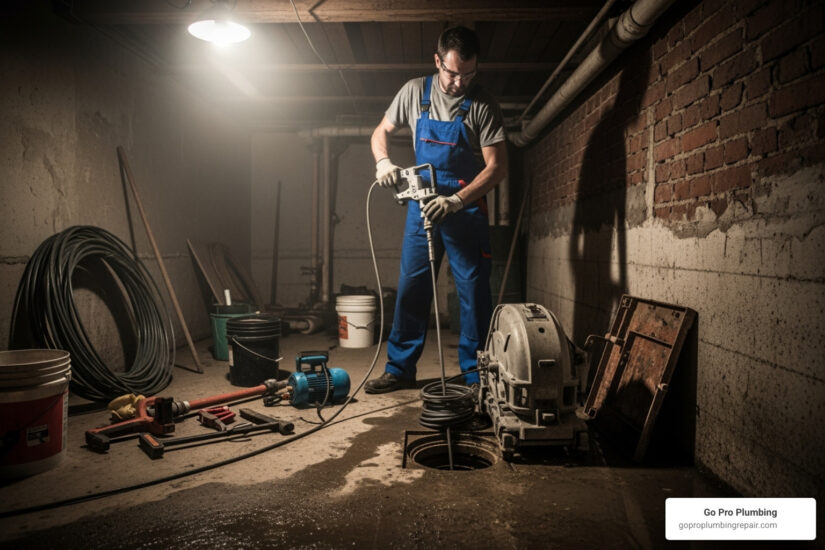
Why Sewer Line Blockage Removal Should Be Your Top Priority
Sewer line blockage removal is one of the most urgent plumbing issues a homeowner can face. A clogged main sewer line affects every drain in your home, potentially causing sewage backups that lead to health hazards and costly water damage.
Quick Answer for Sewer Line Blockage Removal:
- Identify the problem – Look for multiple slow drains, gurgling sounds, and sewage odors.
- Try DIY methods – Use a plumbing auger through the cleanout pipe (tools cost $30-$300).
- Call professionals – For stubborn clogs, tree roots, or broken pipes (costs range from $1,300-$4,950).
- Safety first – Always call 811 before clearing to locate underground utility lines.
- Prevention – Never flush wipes, grease, or foreign objects.
A main sewer line blockage is far more serious than a simple clogged drain. As one expert notes, it can cause “multiple backed-up sinks and toilet waste draining into the tub instead of leaving the house.” The stakes are high, with professional clearing costing thousands and water damage adding even more. Understanding whether you can fix it yourself or need to call a pro is key to saving time, money, and protecting your family’s health.

Simple Sewer line blockage removal glossary:
Is It Your Main Sewer Line? Telltale Signs and Common Culprits
When multiple fixtures act up at once, your plumbing is signaling a main sewer line problem, not just a simple clog. Recognizing the signs can help you avoid a messy and expensive disaster.
Warning Signs of a Main Sewer Line Clog
Your plumbing system usually provides clear warnings before a complete blockage occurs. Look for these red flags:
- Multiple backed-up fixtures: If your toilet, shower, and sinks are all draining slowly or backing up simultaneously, the problem is in the main line they all share.
- Gurgling sounds: Strange gurgles from drains when you flush a toilet mean air is trapped by a blockage.
- Water in unexpected places: If flushing a toilet causes water to appear in your shower or tub, wastewater has no escape route and is backing up to the lowest point.
- Sewage smell: A persistent foul odor in your yard or basement indicates that wastewater or sewer gas is escaping the line.
- Flooding near floor drain: Water backing up from a basement floor drain is a final warning that your main line is almost completely blocked.
If you see these signs, don’t wait. For immediate help, our Sewer and Drain Emergency Services team is ready to respond.
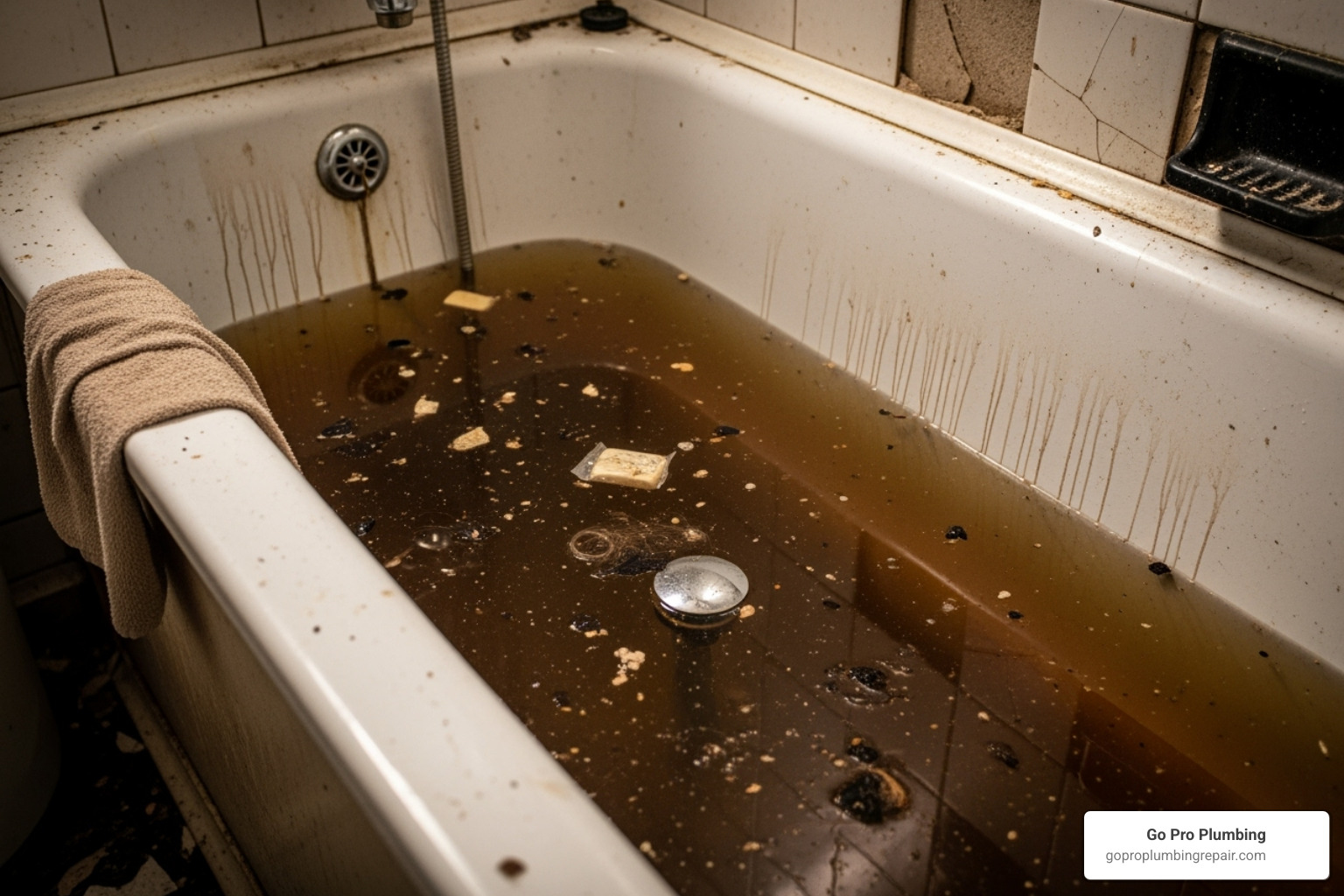
The Most Common Causes of Blockages
Understanding the cause helps determine the solution for sewer line blockage removal.
- Tree root intrusion: Roots are drawn to the water in sewer lines, especially older clay pipes. They grow into dense masses that trap debris and cause severe blockages.
- Grease and fat buildup: Pouring fats, oils, and grease down the drain creates a sticky residue that solidifies in cold pipes, narrowing them over time.
- “Flushable” wipes and foreign objects: Despite marketing claims, so-called “flushable” wipes do not break down like toilet paper. They, along with feminine hygiene products and paper towels, create massive clogs.
- Food waste: Even with a garbage disposal, items like coffee grounds, eggshells, and starchy potato peels can form sludgy blockages.
- Damaged or old pipes: Over time, pipes can crack, shift, or deteriorate, creating rough surfaces that snag debris and lead to recurring clogs.
Prevention is key, but when blockages occur, knowing the cause is the first step. Learn more in our guide to Understanding Sewer Line Services Essentials For Homeowners.
Your Step-by-Step Guide to DIY Sewer Line Blockage Removal
If you’ve identified a main sewer line clog, you might be able to tackle it yourself with the right tools and a cautious approach, potentially saving hundreds of dollars. However, sewer line blockage removal is a messy job, and it’s crucial to know your limits.
Essential Tools for DIY Sewer Line Blockage Removal
Before you start, gather your gear. Safety is non-negotiable when dealing with wastewater.
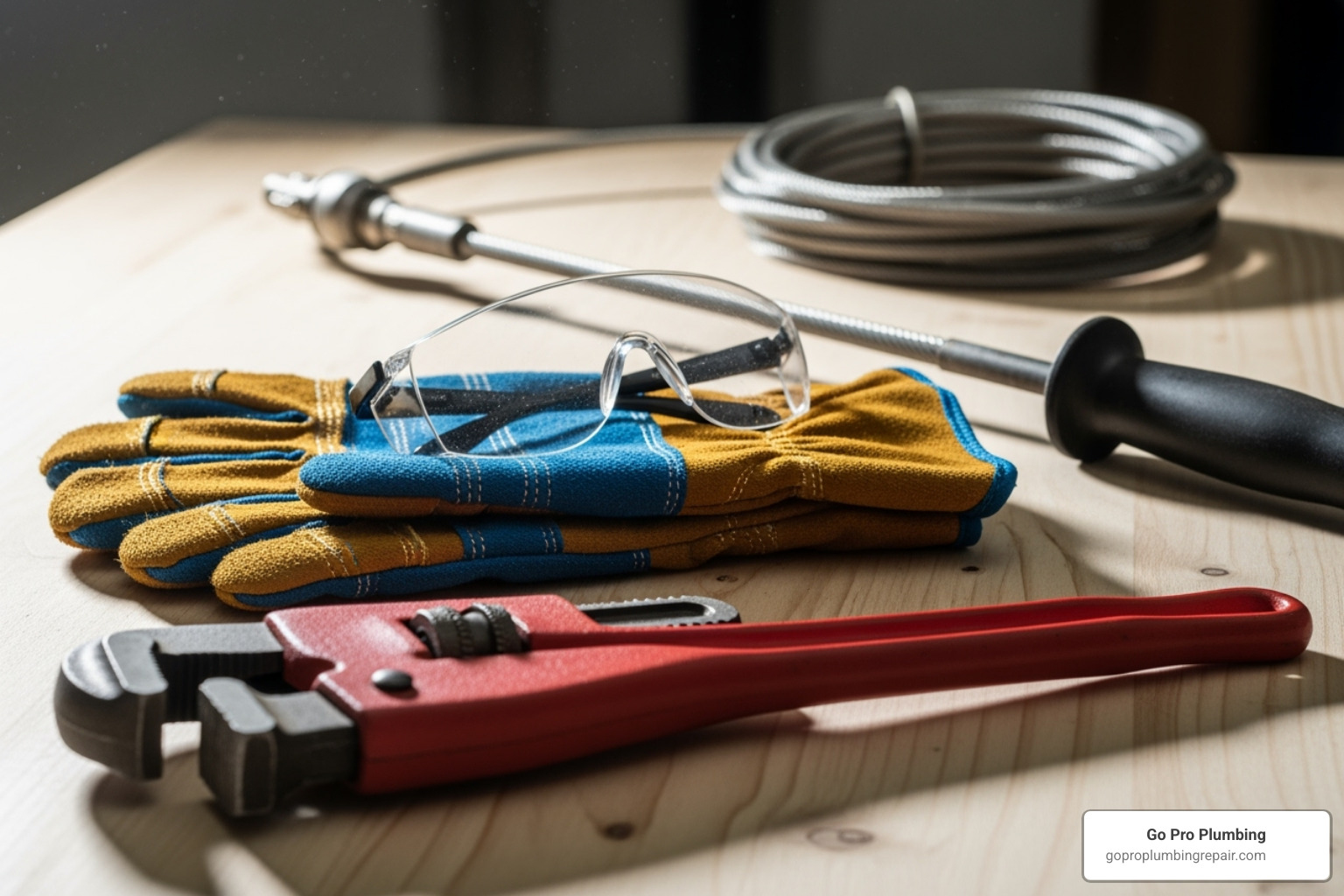
You’ll need:
- Safety Gear: Heavy-duty work gloves and safety glasses are a must.
- Wrench: A pipe or plumbing wrench to open the sewer cleanout cap.
- Plumbing Auger (Snake): A professional-grade auger is your main tool. Manual versions cost around $30, while electric models can be up to $300.
- Hose and Vacuum: A garden hose with a high-pressure nozzle and a wet/dry vacuum for flushing and cleanup.
First, locate your sewer cleanout pipe. It’s a capped pipe (usually 3-4 inches) found in your basement, utility room, or outside near the foundation.
Method 1: Using a Plumbing Auger (Snake)
This is the most effective DIY method for sewer line blockage removal.
- Open the Cleanout: Put on your safety gear. Use the wrench to slowly loosen the cleanout cap. Be prepared for potential wastewater release—stand back as you open it.
- Insert the Auger: Feed the auger cable into the pipe until you feel resistance. You’ve found the clog.
- Break Up the Clog: Activate the auger (or crank the handle) and work the cable back and forth to break up or hook the obstruction. Push past the initial blockage to clear any remaining debris.
- Flush the Line: Slowly retract the auger, hosing it down as it comes out. Once it’s removed, use your garden hose to flush the sewer line for 5-10 minutes to clear any leftover particles.
- Clean Up: Clean your tools thoroughly and securely replace the cleanout cap.
If this doesn’t work, the clog may require professional tools. Learn about our Unclog Sewer services.
Method 2: Natural Solutions for Minor Clogs
For minor grease or soap scum buildup, gentler methods can work.
- Baking Soda and Vinegar: Pour ½ cup of baking soda, then ½ cup of vinegar down the drain. Let it fizz for an hour, then flush with hot water.
- Hot Water Flush: Slowly pouring boiling water down the drain for 5-10 minutes can melt minor grease clogs.
Note: These methods are for individual drains, not severe main line blockages caused by roots or solid objects. For persistent clogs, our Affordable Sewer and Drain Cleaning services are a better option.
Safety First: The Hidden Dangers of Clearing a Sewer Line
While a DIY approach to sewer line blockage removal can be rewarding, it comes with serious hidden dangers. Understanding these risks is crucial to prevent a dangerous and costly accident.
The Risk of Cross Bores and Utility Lines
A “cross bore” occurs when a natural gas line is accidentally installed through a sewer pipe during trenchless drilling operations. This is more common than you might think, as non-metallic sewer lines are difficult to locate from above ground.
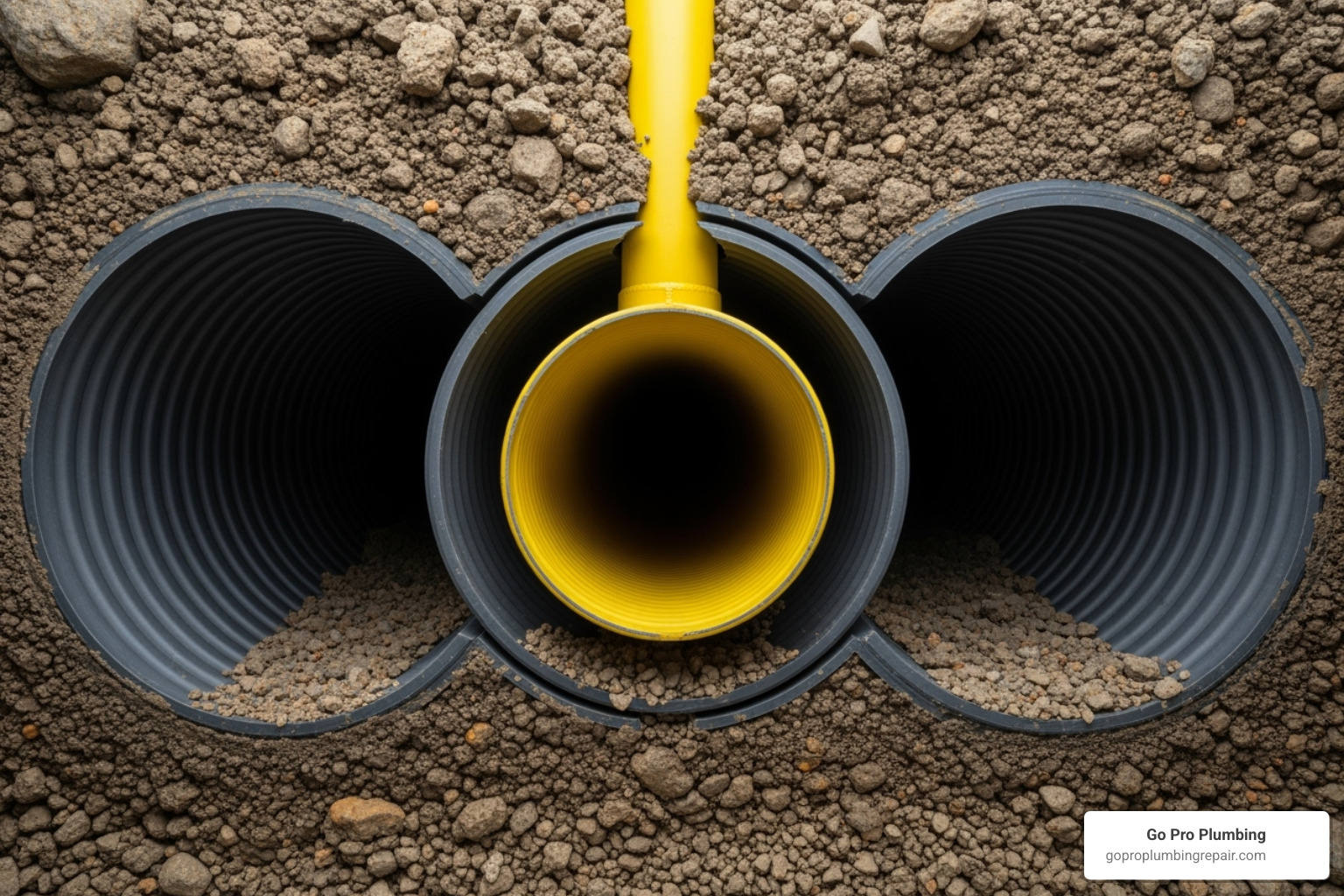
If you use a mechanical auger or hydro-jetter, you could strike the gas line, causing a leak that could lead to an explosion or fire. These cross bores are hidden time bombs waiting for someone to clear a blockage.
Our Golden Rule: Call 811 Before You Clear!
Before using any mechanical equipment on your sewer line, make the free call to 811. This national “calling 811 before you dig” service will help locate underground utilities. It’s the law in many areas and a critical safety step. Emergency inspections are available 24/7. Learn more about calling before you dig to protect yourself and your property. If you ever smell gas, leave the area immediately and call 911 from a safe distance.
Why You Should Avoid Chemical Drain Cleaners
Liquid drain cleaners seem like an easy fix, but they often cause more harm than good.
- Pipe Corrosion: Harsh chemicals like sulfuric acid and lye eat away at your pipes, especially older ones, turning a simple clog into an expensive pipe replacement.
- Harmful Fumes: These products release toxic fumes that can cause respiratory damage and skin burns, especially in enclosed spaces.
- Ineffective on Major Clogs: They are designed for minor hair or soap clogs, not main line blockages from roots or solid objects. The chemicals often just sit on top of the clog, creating a hazardous pool.
- Environmental Hazards: The chemicals harm waterways and can kill the beneficial bacteria in septic systems, leading to system failure.
Instead of chemicals, stick to mechanical methods like snaking or enzymatic cleaners. Always check local guidelines on hazardous household waste disposal for proper chemical handling.
When to Put Down the Wrench: Calling a Professional
There’s satisfaction in a successful DIY repair, but some jobs are best left to professionals. Knowing when to call for expert help with your sewer line blockage removal is a smart decision that protects your home and wallet from bigger problems.
Advanced Sewer Line Blockage Removal: When to Call the Professionals
It’s time to call in the pros when you encounter these situations:
- DIY methods fail: If your auger can’t break through the clog, you’re likely facing a problem that requires professional-grade equipment.
- Suspected broken pipes: Soggy, foul-smelling patches in your yard are a sign of a collapsed or damaged pipe that DIY methods can’t fix and may worsen.
- Major tree root infiltration: While an auger might poke a hole in roots, only powerful hydro-jetting or mechanical rooters can fully clear dense root masses.
- Recurring clogs: If the same blockage keeps coming back, there’s an underlying issue that needs professional diagnosis.
- Sewage in your yard: This is a health hazard that requires immediate professional attention to prevent contamination and property damage.
Yes, professional sewer line blockage removal can cost between $1,300 and $4,950, but this is an investment to prevent catastrophic water damage that can cost tens of thousands. When you need expert help, our Professional Sewer Line Cleaner team is ready.
Homeowner vs. The City: Who is Responsible?
Understanding responsibility can be confusing. Generally:
- You (the homeowner) are responsible for the lateral sewer line, which runs from your home to the property line (usually the street or sidewalk).
- The city/municipality is responsible for the main sewer line that runs under the street.
If your neighbors are experiencing similar issues, the problem is likely in the city’s main line. If it’s just your home, the clog is probably in your lateral line. If you suspect a city issue, contact your local public works department. For more details, watch a video explaining sewer line ownership.
Professional Methods: Hydro Jetting and Camera Inspections
Professionals use advanced technology to solve problems effectively.
- Video Camera Inspection: We feed a camera into your sewer line to get a clear view of the problem—be it roots, grease, or a broken pipe. This eliminates guesswork and ensures the right solution is used.
- Hydro Jetting: This method uses high-pressure water (up to 4,000 PSI) to blast away the most stubborn clogs, including tree roots and heavy grease. It thoroughly cleans the pipe walls, reducing the chance of future blockages. Learn more about our Hydro Jetter Plumbing services.
- Trenchless Sewer Line Repair: If the camera reveals a broken pipe, we can often repair or replace it without extensive digging, saving your yard and landscaping. This trenchless Sewer Line Repair provides a long-term solution.
Proactive Plumbing: How to Prevent Future Sewer Line Clogs
The most effective way to handle a clog is to prevent it from forming. A few simple habits can save you from an emergency sewer line blockage removal call and keep your plumbing healthy.
What You Should Never Flush or Pour Down Drains
Your drains are not a trash can. To avoid clogs, never put these items down your pipes:
- Grease, Fats, and Oils: These solidify in pipes, creating sticky, stubborn blockages. Let grease cool in a can and throw it in the trash.
- Coffee Grounds: They clump together and form sludge. Compost them or throw them away.
- “Flushable” Wipes: These do not break down like toilet paper and are a primary cause of major sewer clogs.
- Feminine Hygiene Products, Paper Towels, Cotton Swabs, and Dental Floss: These items are designed to be absorbent or strong and will snag and tangle, creating blockages.
- Certain Food Scraps: Even with a disposal, avoid sending potato peels, eggshells, and fibrous vegetables down the drain.
- Harsh Chemicals: They can damage your pipes and harm the environment.
The rule is simple: only human waste and toilet paper should go down the toilet.
A Simple Maintenance Schedule for Healthy Pipes
A little proactive care goes a long way in preventing clogs.
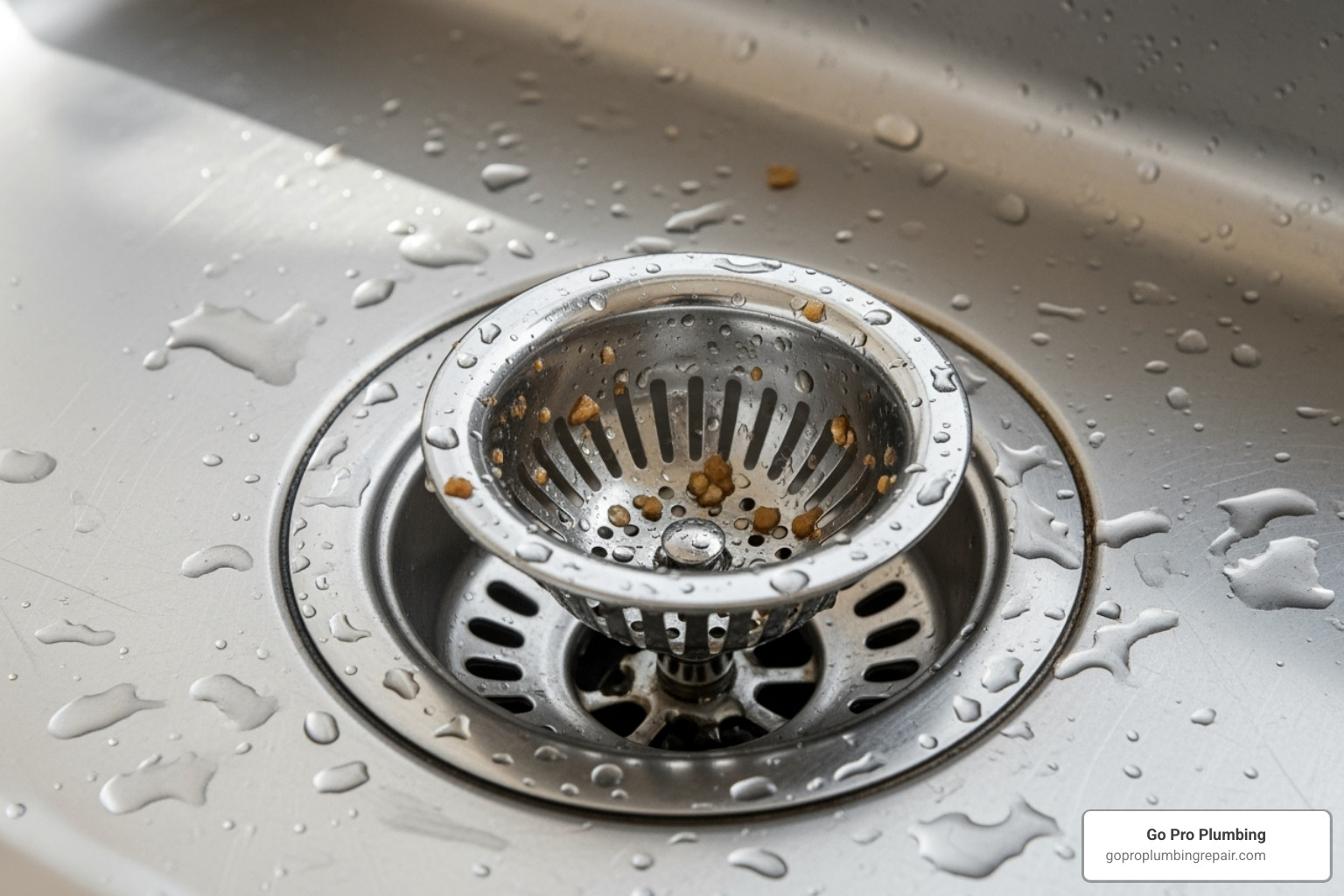
- Use Drain Guards: Place strainers in all sinks and tubs to catch hair and food debris. Clean them regularly.
- Perform Monthly Hot Water Flushes: For kitchen sinks, fill the sink with hot, soapy water and then release it all at once to flush out grease buildup.
- Schedule Professional Inspections: Have your lines inspected every one to two years to catch potential issues early. If you have known tree root problems, consider semi-annual inspections.
- Maintain Your Septic System: If you have a septic tank, have it professionally inspected and pumped every two to three years.
These habits greatly reduce your risk of needing emergency services. For professional maintenance, explore our Sewer Line Cleaning Services.
Frequently Asked Questions about Sewer Line Blockages
We’ve covered a lot, but you might still have questions. Here are concise answers to common inquiries about sewer line blockage removal.
How can I tell if my main sewer line is clogged?
You likely have a main sewer line clog if you notice these signs:
- Multiple fixtures are affected: Sinks, toilets, and showers throughout the house are draining slowly or backing up at the same time.
- You hear gurgling noises: When you run water or flush a toilet, other drains make gurgling sounds as trapped air escapes past a blockage.
- Water backs up in low points: Flushing a toilet causes water or sewage to back up into your shower or a basement floor drain.
- There is a persistent sewage smell: A foul odor from drains or in your yard points to a sewer line issue.
How much does it cost to have a main sewer line cleared?
The cost for professional sewer line blockage removal varies.
- DIY: Tools like a snake or auger can cost between $30 and $300.
- Professional Clearing: For standard blockages using a snake or hydro-jetter, expect to pay between $1,300 and $4,950. The final price depends on the clog’s severity and accessibility.
- Major Repairs: If the pipe is broken and requires excavation or replacement, costs can be much higher. A full replacement can cost $60 to $250 per linear foot.
The cost of clearing a clog is almost always less than the cost of repairing water damage from a sewage backup.
Can tree roots in a sewer line be removed permanently?
Removing tree roots is a two-step process.
- Temporary Removal: Professionals can effectively remove roots using mechanical augers (rooters) or high-pressure hydro-jetting. Hydro-jetting is often more thorough as it cleans the entire pipe wall.
- Permanent Solution: Because roots are attracted to moisture, they will grow back if the pipe has cracks or loose joints. A permanent solution requires fixing the pipe itself. This can be done through trenchless pipe lining, which seals the pipe from the inside, or a full pipe replacement for severely damaged sections. Chemical root killers can be used, but they don’t fix the entry point and should be handled with professional guidance.
A Clear Path Forward for Your Plumbing
Dealing with a main sewer line blockage removal is a serious challenge, but you now have the knowledge to act effectively. By recognizing warning signs like multiple slow drains and gurgling sounds, you can address problems before they become a catastrophe.
While a DIY approach with an auger can solve minor clogs, there’s no shame in knowing your limits. Complex blockages demand professional expertise. For invasive tree roots, recurring clogs, or suspected broken pipes, calling a professional is the safest and most effective choice. The risks of DIY mistakes, from damaged pipes to dangerous cross bores, are too high.
The cost of professional service ($1,300 to $4,950) is an investment in protecting your home from sewage backups, which can lead to far more expensive water damage and health hazards. The best strategy is always prevention: be mindful of what goes down your drains and schedule regular inspections.
When you need a reliable, same-day solution for your sewer line problems, the Go Pro Plumbing team is here to help. We will diagnose the root cause and restore your plumbing to perfect working order with our comprehensive sewer line services. Trust our expertise to ensure your family’s comfort and safety.
